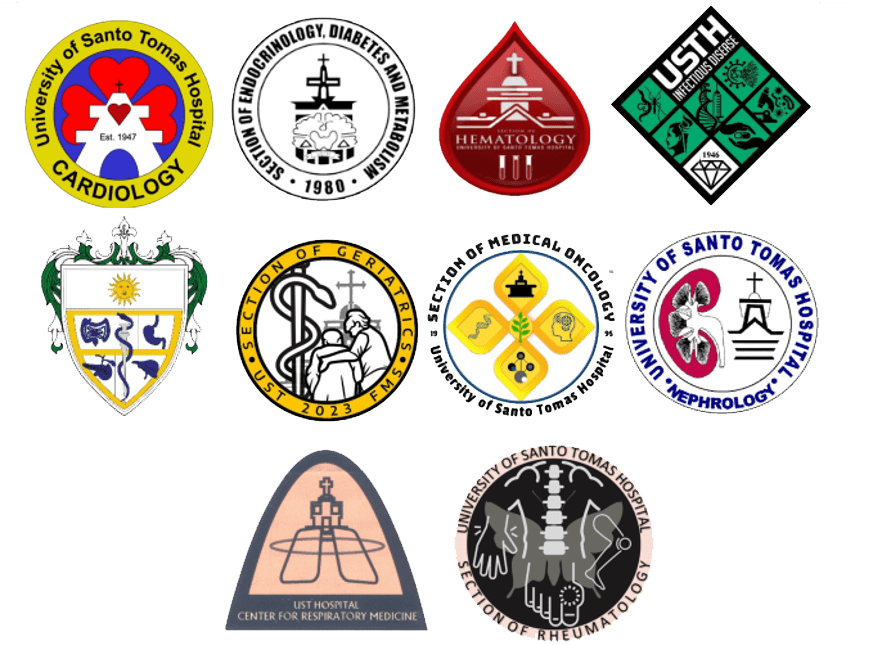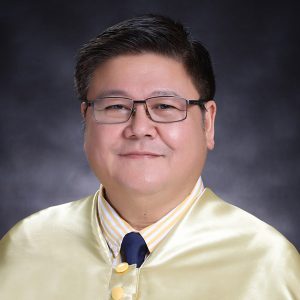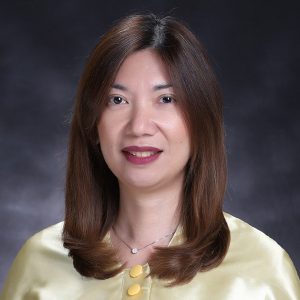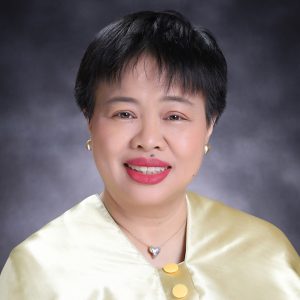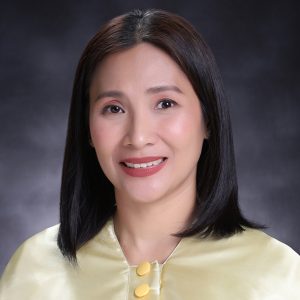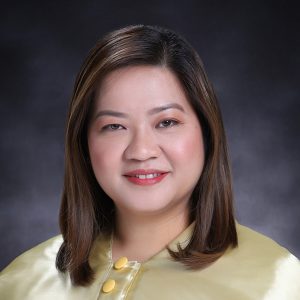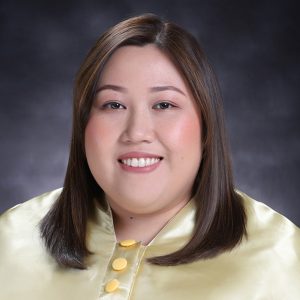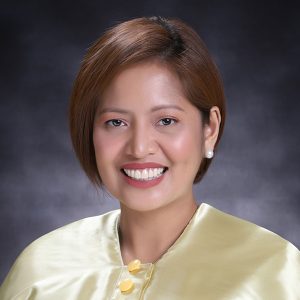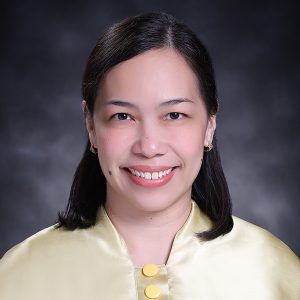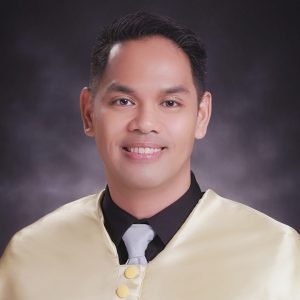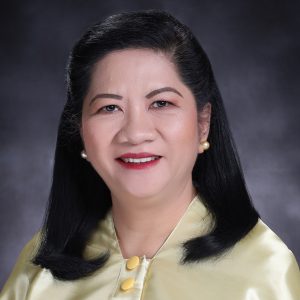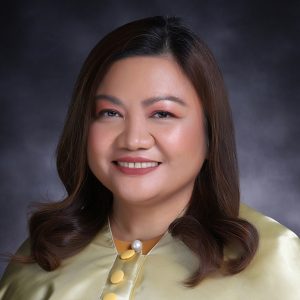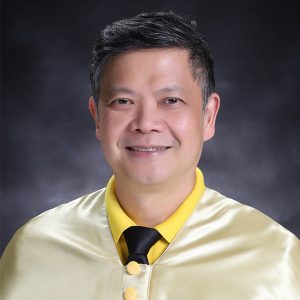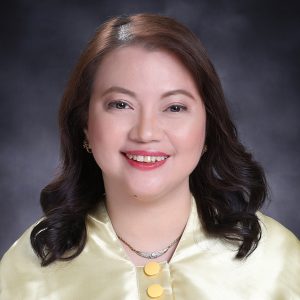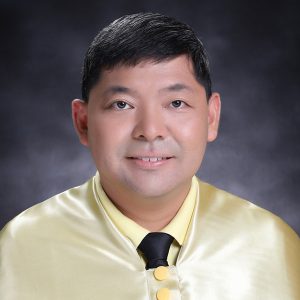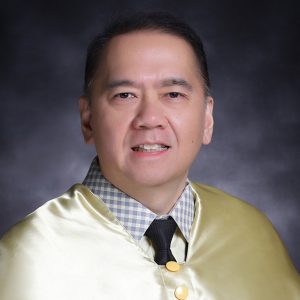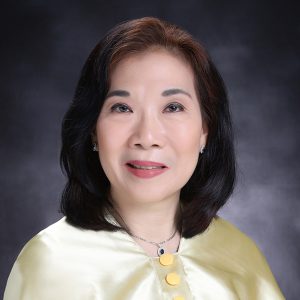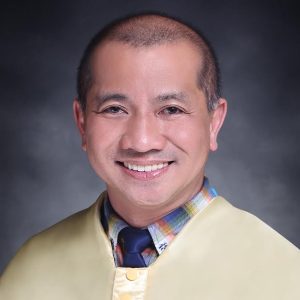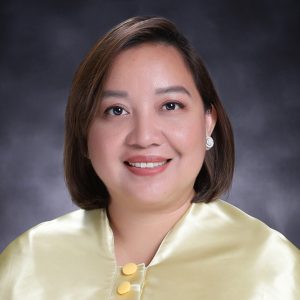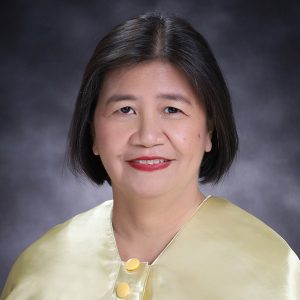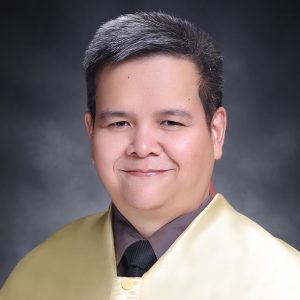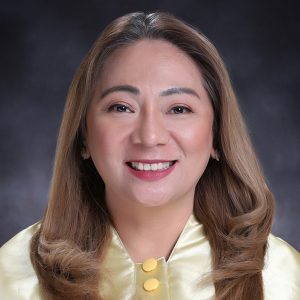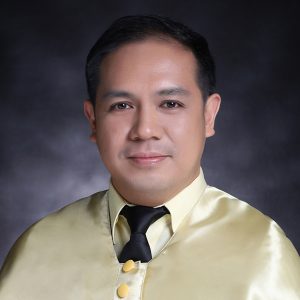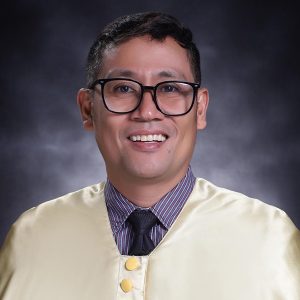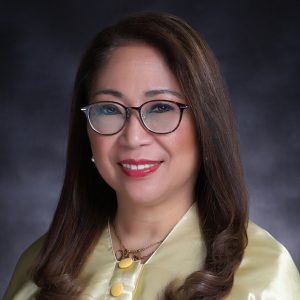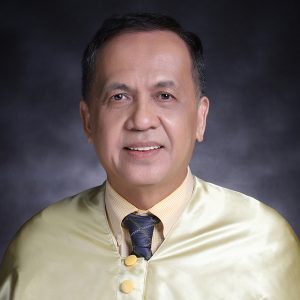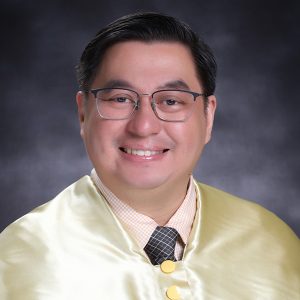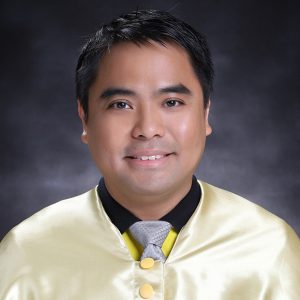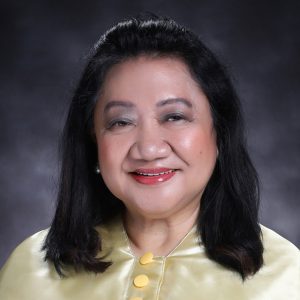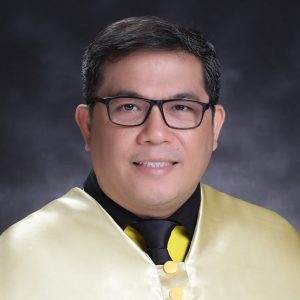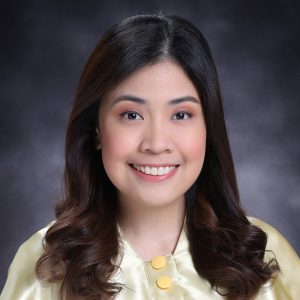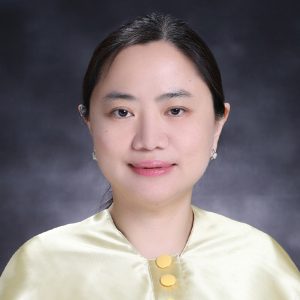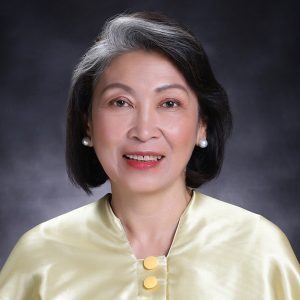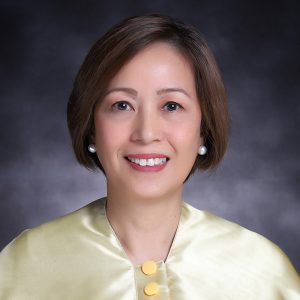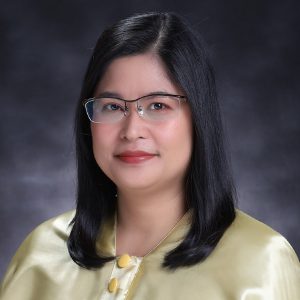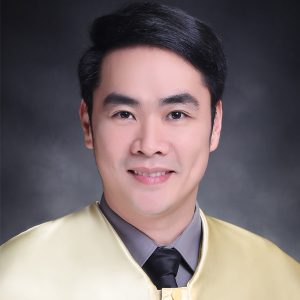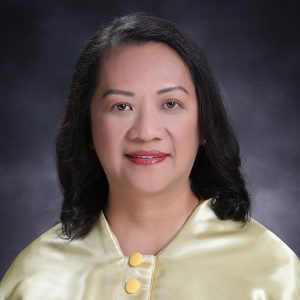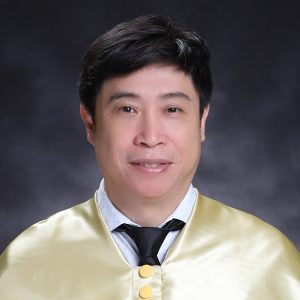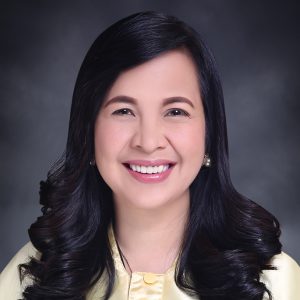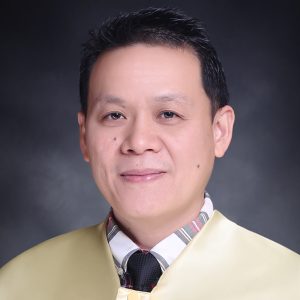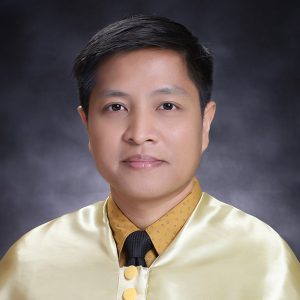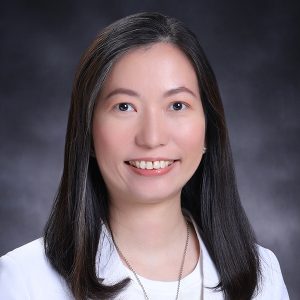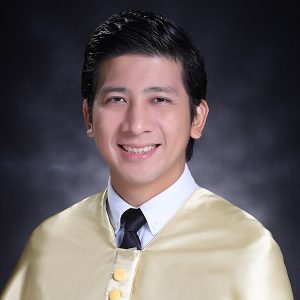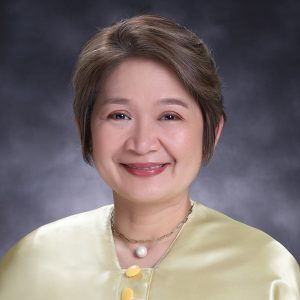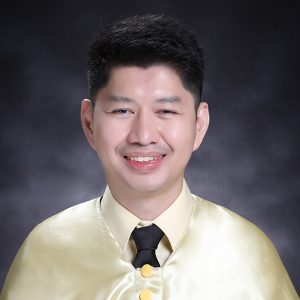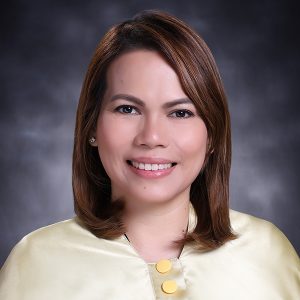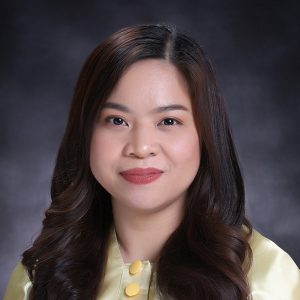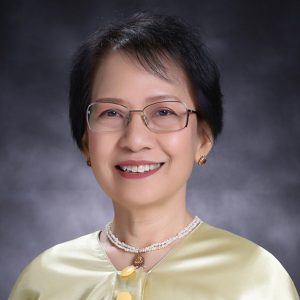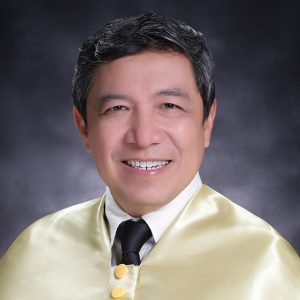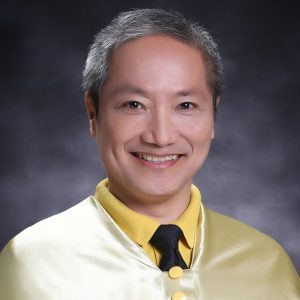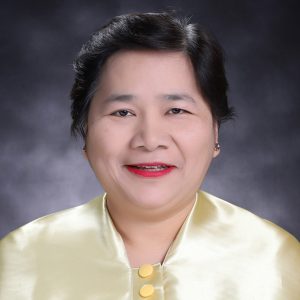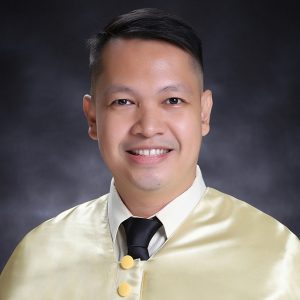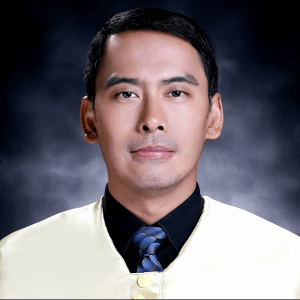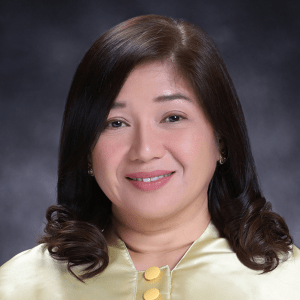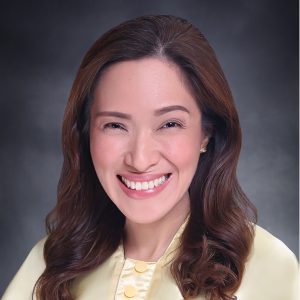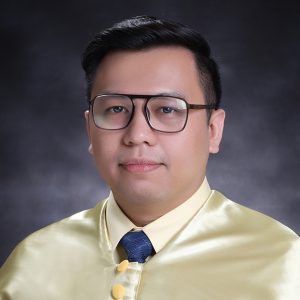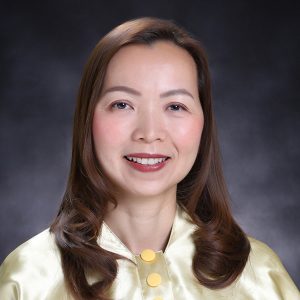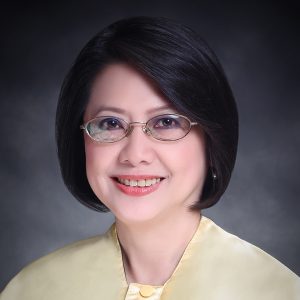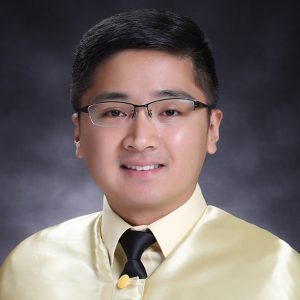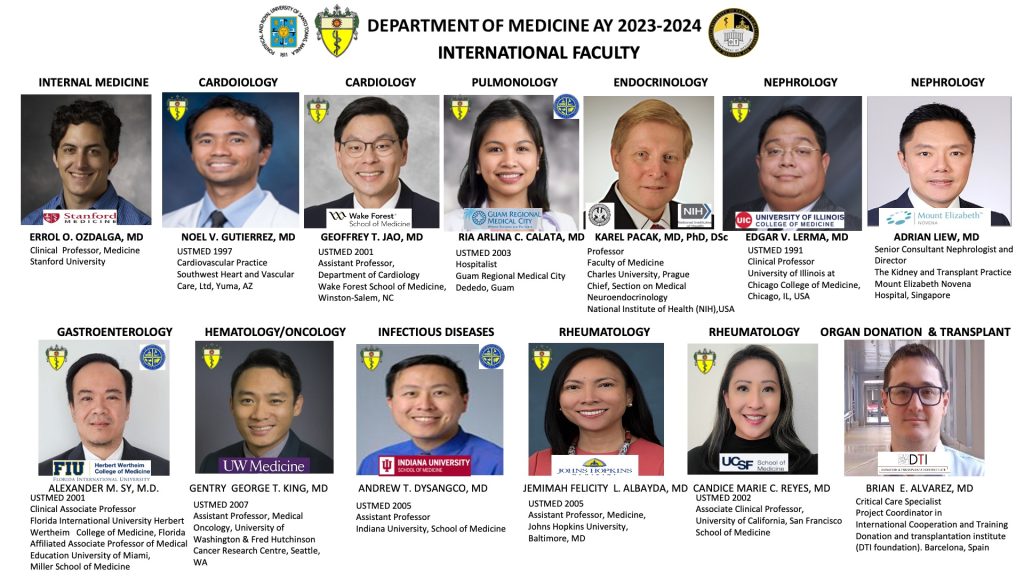Dr. Maria Piedad R. Natividad (2019-2021)

Dr. Natividad’s initial thrust as Chairman of the Department was to increase activities that could boost the clinical learning experience of the students. She promoted activities that provided interaction among students and patients: “Patient Assist Program” (PAP) and “Patient as Teachers” (PAT), as well as the use of videos, “Video Assist Project “(VAP) that demonstrated the UST techniques, particularly in Physical examination, as well as mannequins “Dummy Assist Project” (DAP) that allowed the students to hone their skills in both Physical examination techniques as well as procedures that they would be doing as clerks. There was also an increase in the utilization of the Ultrasound, “Turn Up the Sound”, to enhance anatomical and clinical correlation. Team Based Learning TBL was also continued since this encouraged group participation and collaboration.
Dr. Natividad also started the Student Assist Program (SAP), where the Department Chair regularly reached out to talk to the students who were having difficulty in maintaining passing grades. These conversations made it possible to determine actions that could help the students, including referrals to the Guidance Councilor. Regular follow-ups were also done to ensure that the students continued to receive the assistance that they needed.
Community and environmental activities were also promoted, with virtual lay fora, participation in the medical mission of Simbahayan, as well as a Tree Planting activity as part of the Kalikasan, Kabuhayan, Kaibigan Project (KKK).
Dr. Natividad was still Chairman when the world was struck by the Coronavirus (CoVid-19) pandemic in 2020 and the university shifted to pure online classes to minimize exposure to the virus. The faculty adapted successfully, with quick modification of the curriculum and realignment of the modules to the virtual platform.
During the COVID-19 pandemic, the “Patient as Teachers” (PAT) Project was continued virtually to meet educational challenges by leveraging technology and available resources while ensuring the safety of students and staff. Subspecialty sections incorporated telemedicine to provide actual patients for teaching modules. Some Modules also used virtual “patient encounters” that allowed the clinical clerks to “experience” the management of a patient from the ER, to the ward, to discharge, and even to a Telemedicine follow-up, simulating actual patient management as closely as possible.
Once on-campus activities were allowed, intensive workshops were held with strict physical distancing, where students used models and dummies to improve their physical examination and basic clinical procedure skills under the Dummy Assist Project (DAP). The Video Assist Project (VAP) was also continued, integrating standard physical examination technique videos into all physical exam lectures. Meanwhile, well-screened USTFMS support staff acted as model patients, allowing medical students to practice history-taking and focused physical examination skills safely.
These innovations ensured the continuity and quality of medical education during the pandemic and have established new standards that continue to benefit students and patients.
Dr. Sjoberg Kho served as her Department Secretary. Dr. Irene Vergara-Joson was the Medicine 1 Supervisor, Dr. Marie Stella Navarro was the Medicine 2 Supervisor, while Dr. Melvin Marcial was the Medicine 3 Supervisor. The section chiefs included Dr. Maria Victoria Garcia for Cardiology, Dr. Maria Piedad Natividad for Pulmonary, Dr. Porshia Comes-Natividad for Nephrology, Dr. Honolina Gomez for Endocrinology, Dr. Frederick Dy for Gastroenterology, Dr. Priscilla Caguioa for Hematology/Oncology, Dr. Julie Li-Yu for Rheumatology, and Dr. Rhona Bergantin for Infectious Disease.
Dr. Sjoberg A. Kho UST HOSPITAL (2020- )

Dr. Kho took the reins as Chairman of the Department of Internal Medicine of the UST Hospital leading the premiere department amidst the deadly pandemic. Under his guidance, the training of medical residents and fellows was modified and major changes were made in the operation of the hospital units, following guidelines during the pandemic and the new normal. He initiated several online/hybrid postgraduate courses under the department.
The section chiefs included Dr. MIlagros Yamamoto for Cardiology, Dr. Julius Dalupang Pulmonary, Dr. Romina Laguesma-Navarro for Nephrology, Dr. Sjoberg Kho for Endocrinology, Dr. Frederick Dy for Gastroenterology, Dr.Irene Castillo for Hematology/Oncology, Dr. Sandra Navarra for Rheumatology, and Dr. Remedios Coronel for Infectious Disease.
UST Hospital Unit Heads during this time were the following: Cardiovascular Catheterization Unit: Dr. Wilson Tan-De Guzman; Center for Kidney Diseases: Dr. Marie Stella L. Navarro; Center for Respiratory Medicine: Dr. Julius Caesar J. Dalupang; Diabetes Center: Dr. Sjoberg A. Kho; Endoscopy Unit: Dr. Frederick T. Dy; Heart Station: Dr. Eduardo Vicente S. Caguioa; Intensive Care Units (CCU/CVU): Dr. Milagros E. Yamamoto; Infection Prevention and Control Committee (IPCC): Dr. John S. Delgado, and Rheumatology Center: Dr. Julie Li-Yu. Dr. Julie Visperas served as the Residency Training officer succeeded by Dr. Cristina Maranon.





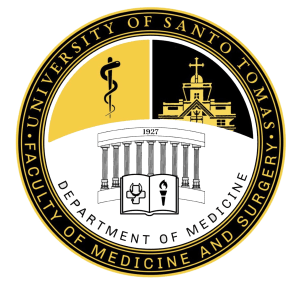

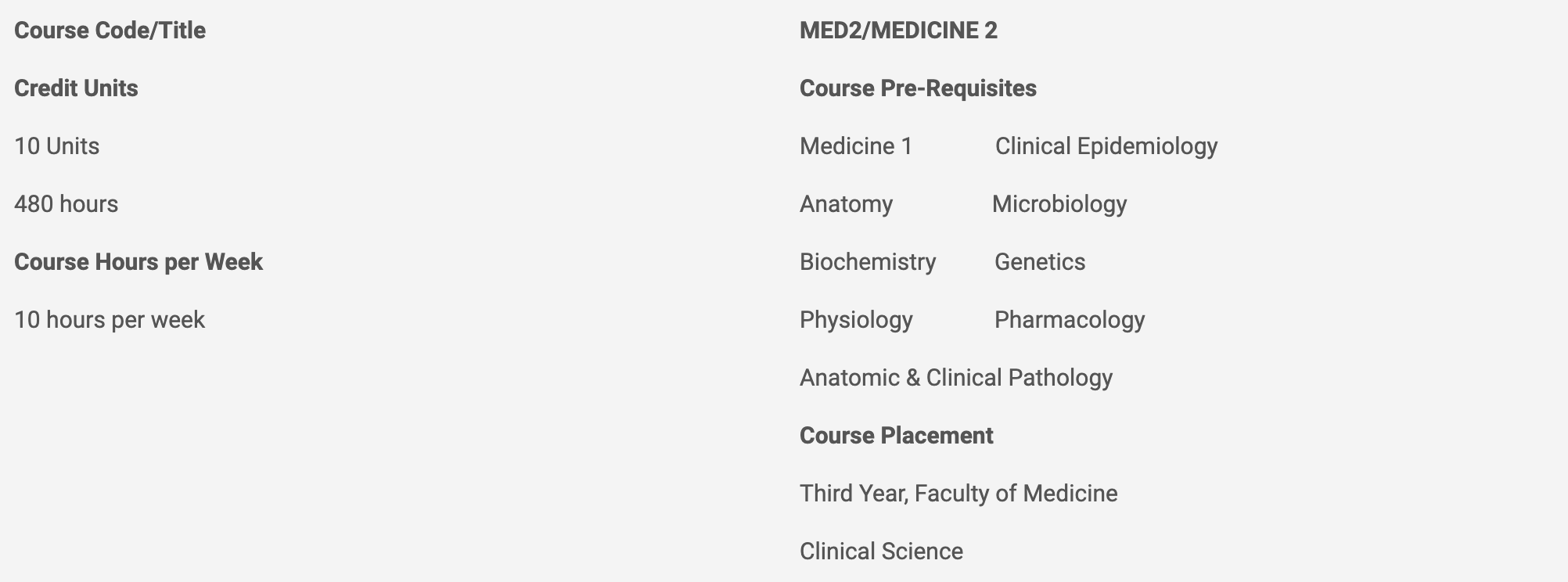

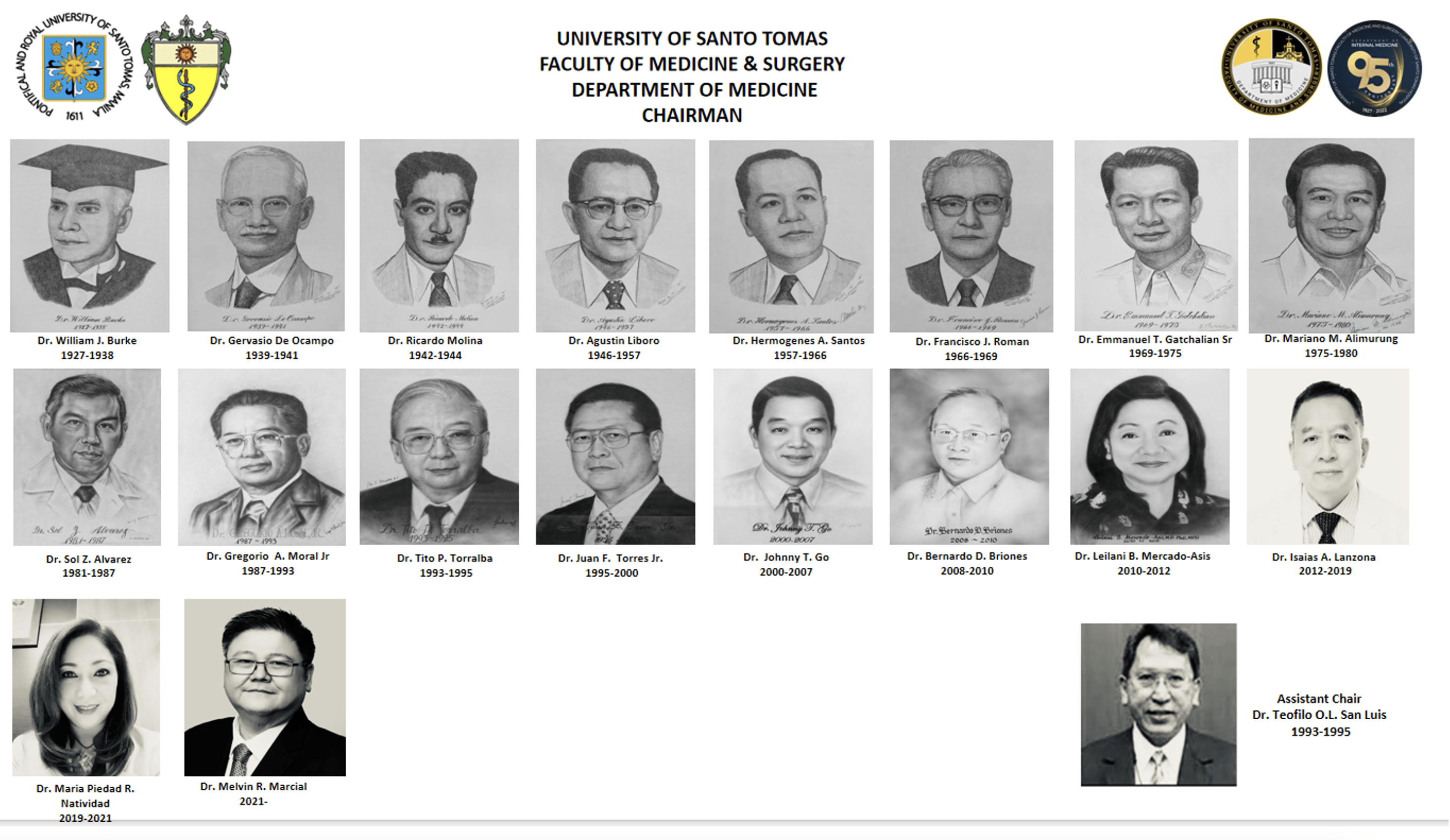
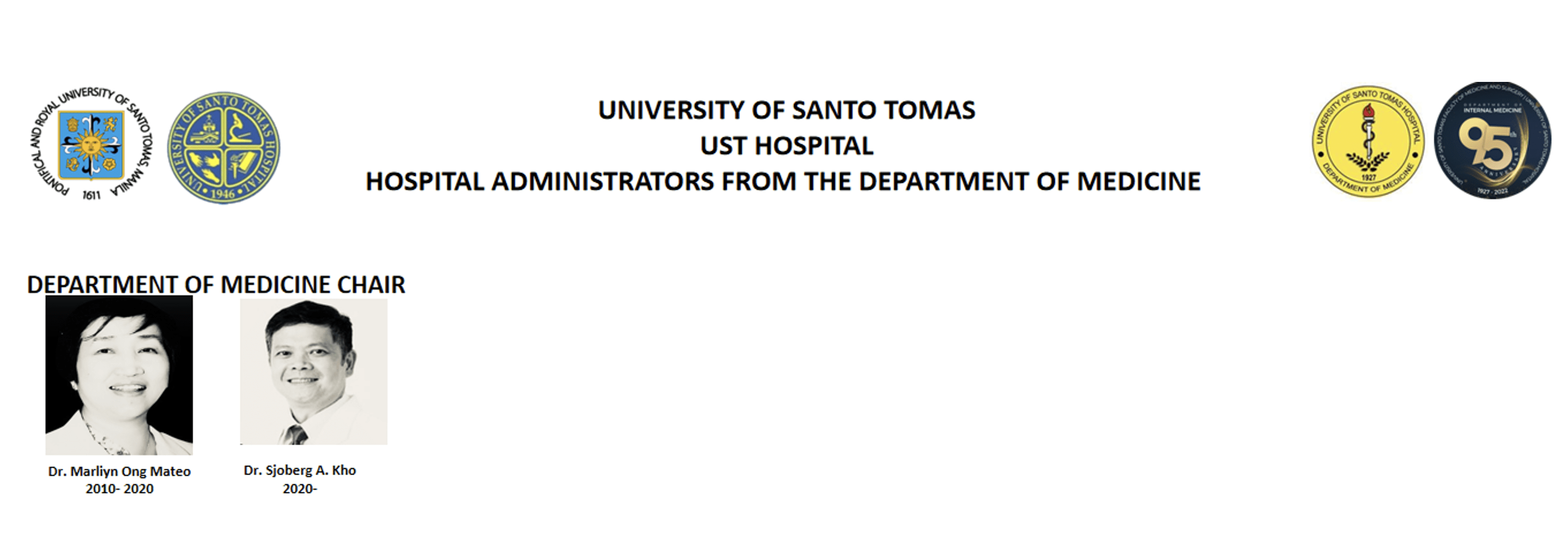
 It was only in 1927 when the Department of Medicine was first formally organized. Dr. William Burke, a cardiologist and philanthropist, served as its head up to 1938, with Dr. Gervasio de Ocampo as Assistant Head. Dr. Burke is the one that introduced and installed the first electrocardiograph in the Philippines.
It was only in 1927 when the Department of Medicine was first formally organized. Dr. William Burke, a cardiologist and philanthropist, served as its head up to 1938, with Dr. Gervasio de Ocampo as Assistant Head. Dr. Burke is the one that introduced and installed the first electrocardiograph in the Philippines. Dr. de Ocampo succeeded Dr. Burke as head in the years before World War II from 1939 to 1941. The Department at that time was composed of the following sections: Physical Diagnosis, Pharmacology Therapeutics and Prescription Writing, Radiology, Psychiatry, Tropical Medicine, Communicable diseases , Dermatology and Syphilology, Clinical Pathology and Medical Pathology. It was also during this time that 1st and 2nd classes were held at the present España while clinical years remained in the Walled City of Intramuros, San Juan de Dios Hospital.
Dr. de Ocampo succeeded Dr. Burke as head in the years before World War II from 1939 to 1941. The Department at that time was composed of the following sections: Physical Diagnosis, Pharmacology Therapeutics and Prescription Writing, Radiology, Psychiatry, Tropical Medicine, Communicable diseases , Dermatology and Syphilology, Clinical Pathology and Medical Pathology. It was also during this time that 1st and 2nd classes were held at the present España while clinical years remained in the Walled City of Intramuros, San Juan de Dios Hospital.
 Amidst the ruins of the war, the University re-opened its door in 1945 and a new University Hospital was installed at the España campus. On February 15, 1946, the Charity Service opened. Dr. Agustin Liboro became the Head of Medicine (1946-1957) with Dr. Mariano Alimurung as Secretary (1946-1947). Post-liberation years were characterized by the departure of some staff members for further study and training abroad. Dr. Antonio Samia succeeded Dr. Alimurung as Secretary from 1948 to 1951 with Dr. Carmen Salgado-Ora as Assistant Secretary. Dr. Ora succeeded Dr. Samia as Secretary from 1952 to 1957 with Dr. Pilar Nacu as Assistant Secretary. It was in 1947 when the different Sections under the Department were organized with their following respective section Chiefs: Dr. Pedro Lantin, Infectious & Tropical Diseases; Dr. Agustin Liboro, Gastrointestinal Diseases; Dr. Hermogenes Santos, Metabolic and Deficiency Diseases; Dr. Wenceslao Vitug, Respiratory Diseases; Dr. Isidro Pertierra, Cardiovascular, Renal and Endocrine Diseases; Dr. Victorino de la Fuente, Hematological Diseases; Dr. Leopoldo Pardo, Neurology & Psychiatry; Dr Paulino Garcia, Radiology and Physiotherapy; Dr. Ernesto Medina-Cua, Venereology & Dermatology; Dr. Antonio Gabriel, Legal Medicine and History of Medicine; and Dr. Hipolito Gatchalian, Therapeutics.
Amidst the ruins of the war, the University re-opened its door in 1945 and a new University Hospital was installed at the España campus. On February 15, 1946, the Charity Service opened. Dr. Agustin Liboro became the Head of Medicine (1946-1957) with Dr. Mariano Alimurung as Secretary (1946-1947). Post-liberation years were characterized by the departure of some staff members for further study and training abroad. Dr. Antonio Samia succeeded Dr. Alimurung as Secretary from 1948 to 1951 with Dr. Carmen Salgado-Ora as Assistant Secretary. Dr. Ora succeeded Dr. Samia as Secretary from 1952 to 1957 with Dr. Pilar Nacu as Assistant Secretary. It was in 1947 when the different Sections under the Department were organized with their following respective section Chiefs: Dr. Pedro Lantin, Infectious & Tropical Diseases; Dr. Agustin Liboro, Gastrointestinal Diseases; Dr. Hermogenes Santos, Metabolic and Deficiency Diseases; Dr. Wenceslao Vitug, Respiratory Diseases; Dr. Isidro Pertierra, Cardiovascular, Renal and Endocrine Diseases; Dr. Victorino de la Fuente, Hematological Diseases; Dr. Leopoldo Pardo, Neurology & Psychiatry; Dr Paulino Garcia, Radiology and Physiotherapy; Dr. Ernesto Medina-Cua, Venereology & Dermatology; Dr. Antonio Gabriel, Legal Medicine and History of Medicine; and Dr. Hipolito Gatchalian, Therapeutics. In July 1957, Dr. Hermogenes A. Santos succeeded Dr. Liboro with Dr. Salgado-Ona as Assistant Head and Dr. Pilar Nacu as Secretary. Dr. Gregorio Moral succeeded Dr. Ora when the later left for abroad and Dr. Aurora Perez served as Assistant Secretary. During this time, Dr. Santos initiated innovations forming different committees for the improvement of the Department. Dr. Francisco Roman was chairman of the Organization and Planning Committee, and Student’s Promotion, Test and Measurement was headed by Dr. Hermogenes Santos. The Therapeutics and Diagnosis Committees were headed by Drs. Wenceslao Vitug and Augustin Liboro, respectively.
In July 1957, Dr. Hermogenes A. Santos succeeded Dr. Liboro with Dr. Salgado-Ona as Assistant Head and Dr. Pilar Nacu as Secretary. Dr. Gregorio Moral succeeded Dr. Ora when the later left for abroad and Dr. Aurora Perez served as Assistant Secretary. During this time, Dr. Santos initiated innovations forming different committees for the improvement of the Department. Dr. Francisco Roman was chairman of the Organization and Planning Committee, and Student’s Promotion, Test and Measurement was headed by Dr. Hermogenes Santos. The Therapeutics and Diagnosis Committees were headed by Drs. Wenceslao Vitug and Augustin Liboro, respectively. On September 1, 1966, Dr. Francisco J. Roman became the Head of the Department and re-organized the Clinical Services into four major divisions ‒ Cardiovascular Diseases, with Dr. Mariano Alimurung as Head; Gastroenterology with Dr. Francisco Roman himself as Chief, and Dr. Ricardo Reyes as Officer-in-Charge; Infectious and Tropical Diseases with Drs. Aniceta Barcelon Guevarra and Joaquin Tinio as Chief and Officer-in-Charge respectively, and Internal Medicine with Dr. Hermogenes Santos as Chief. It was during this time when many returning physicians with specialty training in the subspecialties were appointed to the staff. It was also at this time that Neurology and Psychiatry separated from the Department of Medicine to become a new Department headed by Dr. Gilberto Gamez, with the blessings of Dean Buenaventura Angtuaco and Very Rev. Fr. Jesus Diaz, O.P.
On September 1, 1966, Dr. Francisco J. Roman became the Head of the Department and re-organized the Clinical Services into four major divisions ‒ Cardiovascular Diseases, with Dr. Mariano Alimurung as Head; Gastroenterology with Dr. Francisco Roman himself as Chief, and Dr. Ricardo Reyes as Officer-in-Charge; Infectious and Tropical Diseases with Drs. Aniceta Barcelon Guevarra and Joaquin Tinio as Chief and Officer-in-Charge respectively, and Internal Medicine with Dr. Hermogenes Santos as Chief. It was during this time when many returning physicians with specialty training in the subspecialties were appointed to the staff. It was also at this time that Neurology and Psychiatry separated from the Department of Medicine to become a new Department headed by Dr. Gilberto Gamez, with the blessings of Dean Buenaventura Angtuaco and Very Rev. Fr. Jesus Diaz, O.P.

 Dr. Sol Z. Alvarez succeeded Dr. Alimurung to become the Chairman from 1981 to 1987. Dr. Juan Torres served as Secretary with Dr. Aurora Padolina-Perez as Treasurer. The following physicians became Chief of their respective sections ‒ Dr. Aurora V. Cinco, Allied Specialties; Dr. Bienvenido Alora, Infectious Diseases; Dr. Francisco Dizon, Cardiology; Dr. Perpetua Reyes-Javier, Dermatology; Dr. Luz Alisangco-Gamez, Clinical Pathology; Dr. Lilia Lopez-Borja, Medical Oncology; Dr. Ernesto Brion, Forensic Medicine. During his term as chairman, Dr. Alvarez had a dual role, also serving as Chief of Section of Gastroenterology. He strengthened the Residency Program by having the hairman’s Audit, Admitting Conferences and Research Paper Presentation. He also initiated the Fellowship Program, with Drs. Ramon Carpio (Gastroenterology) and Oscar Naidas (Nephrology) as pioneers. Clinical and teaching fellowship was started during this time with Drs. Rosario Yabon and Sandra Teresa G. Victorio-Navarra. Dr. Alvarez paved the way to the separation of Dermatology, Clinical Pathology and Forensic Medicine from the Department with Dr. Tito P. Torralba as the Dean. He also started to rekindle the glorious days of the Department by holding Foundation Day celebrations. Dr. Alvarez continued the programs initiated by Dr. Alimurung, e.g. weekly chairman’s rounds, admitting conferences, audit, morbidity and mortality conferences. Presently, such activities are still being conducted. Dr. Alvarez renamed Residents’ Paper Presentation to Mariano Alimurung Research Paper Contest.
Dr. Sol Z. Alvarez succeeded Dr. Alimurung to become the Chairman from 1981 to 1987. Dr. Juan Torres served as Secretary with Dr. Aurora Padolina-Perez as Treasurer. The following physicians became Chief of their respective sections ‒ Dr. Aurora V. Cinco, Allied Specialties; Dr. Bienvenido Alora, Infectious Diseases; Dr. Francisco Dizon, Cardiology; Dr. Perpetua Reyes-Javier, Dermatology; Dr. Luz Alisangco-Gamez, Clinical Pathology; Dr. Lilia Lopez-Borja, Medical Oncology; Dr. Ernesto Brion, Forensic Medicine. During his term as chairman, Dr. Alvarez had a dual role, also serving as Chief of Section of Gastroenterology. He strengthened the Residency Program by having the hairman’s Audit, Admitting Conferences and Research Paper Presentation. He also initiated the Fellowship Program, with Drs. Ramon Carpio (Gastroenterology) and Oscar Naidas (Nephrology) as pioneers. Clinical and teaching fellowship was started during this time with Drs. Rosario Yabon and Sandra Teresa G. Victorio-Navarra. Dr. Alvarez paved the way to the separation of Dermatology, Clinical Pathology and Forensic Medicine from the Department with Dr. Tito P. Torralba as the Dean. He also started to rekindle the glorious days of the Department by holding Foundation Day celebrations. Dr. Alvarez continued the programs initiated by Dr. Alimurung, e.g. weekly chairman’s rounds, admitting conferences, audit, morbidity and mortality conferences. Presently, such activities are still being conducted. Dr. Alvarez renamed Residents’ Paper Presentation to Mariano Alimurung Research Paper Contest.
 Dr. Torralba envisioned to strengthen the subspecialties and to maximize the potentials of a highly trained subspecialty-based faculty staff. Dr. Teofilo O.L. San Luis served as his Assistant Department Chair. The Section of Allied Specialties was dissolved and five new sections were created : Pulmonary and Critical Care Medicine, Hematology and Oncology, Rheumatology and Clinical Immunology, Nephrology and Endocrinology and Metabolism , making up the total of 8 sections under the Department including the already existing Sections of Cardiology, Infectious and Tropical Diseases and Gastroenterology. These Sections were headed by seasoned specialists such as Dr. Alberto Lardizabal, pulmonologist; Dr. Carmen Tanseco-Narciso, haematologist; Dr. Tito P. Torralba, rheumatologist, Dr. Libertad Nazareno-Rosales, nephrologist; Dr. Edna Garayblas-Monzon, cardiologist; Dr. Jesus Y. Perez, gastroenterologist; Dr. Juna F. Torres, endocrinologist and Dr. Angeles Tan Alora, Infectious Disease specialist The term of Dr. Torralba saw the renovation of the wards as well as the establishment of the Peritoneal dialysis Unit and the Research Laboratory now MIC (Medical Informatics Center). He also initiated the Conference on Therapy with the Department of Pharmacology and highlighted each Sections and specialty consultants through a well-prepared Medical Grand rounds. He also gave opportunity to newly graduates but deserving trainees by appointing them as Clinical Faculties.
Dr. Torralba envisioned to strengthen the subspecialties and to maximize the potentials of a highly trained subspecialty-based faculty staff. Dr. Teofilo O.L. San Luis served as his Assistant Department Chair. The Section of Allied Specialties was dissolved and five new sections were created : Pulmonary and Critical Care Medicine, Hematology and Oncology, Rheumatology and Clinical Immunology, Nephrology and Endocrinology and Metabolism , making up the total of 8 sections under the Department including the already existing Sections of Cardiology, Infectious and Tropical Diseases and Gastroenterology. These Sections were headed by seasoned specialists such as Dr. Alberto Lardizabal, pulmonologist; Dr. Carmen Tanseco-Narciso, haematologist; Dr. Tito P. Torralba, rheumatologist, Dr. Libertad Nazareno-Rosales, nephrologist; Dr. Edna Garayblas-Monzon, cardiologist; Dr. Jesus Y. Perez, gastroenterologist; Dr. Juna F. Torres, endocrinologist and Dr. Angeles Tan Alora, Infectious Disease specialist The term of Dr. Torralba saw the renovation of the wards as well as the establishment of the Peritoneal dialysis Unit and the Research Laboratory now MIC (Medical Informatics Center). He also initiated the Conference on Therapy with the Department of Pharmacology and highlighted each Sections and specialty consultants through a well-prepared Medical Grand rounds. He also gave opportunity to newly graduates but deserving trainees by appointing them as Clinical Faculties.



 From February-May 2010, Dr. Marilyn Ong-Mateo acted as OIC (Officer-in- Charge) of the Department. While awaiting the appointment of the next chairman, Dr. Graciela Garayblas-Gonzaga, who was Dean of the Faculty of Medicine and Surgery and Internist, served as OIC (Officer-in- Charge) from June-October 2010. Both Dr. Marilyn Ong-Mateo and Dean Graciela Grarayblas-Gonzaga continued the projects of Dr. Briones foremost of which was the formation of the Curriculum Committee to validate examination questions in Medicine I and II. With the change in the landscape of medicine and healthcare and a strong need for realignment and strategic management of the hospital units and departments, a separate Department Chairman for the UST Hospital was appointed in 2011. Dr Ong-Mateo served and lead the Department of Internal Medicine in the hospital from 2011 until 2020., where she took the challenge of handling the biggest department with the greatest number of operating units.
From February-May 2010, Dr. Marilyn Ong-Mateo acted as OIC (Officer-in- Charge) of the Department. While awaiting the appointment of the next chairman, Dr. Graciela Garayblas-Gonzaga, who was Dean of the Faculty of Medicine and Surgery and Internist, served as OIC (Officer-in- Charge) from June-October 2010. Both Dr. Marilyn Ong-Mateo and Dean Graciela Grarayblas-Gonzaga continued the projects of Dr. Briones foremost of which was the formation of the Curriculum Committee to validate examination questions in Medicine I and II. With the change in the landscape of medicine and healthcare and a strong need for realignment and strategic management of the hospital units and departments, a separate Department Chairman for the UST Hospital was appointed in 2011. Dr Ong-Mateo served and lead the Department of Internal Medicine in the hospital from 2011 until 2020., where she took the challenge of handling the biggest department with the greatest number of operating units.




